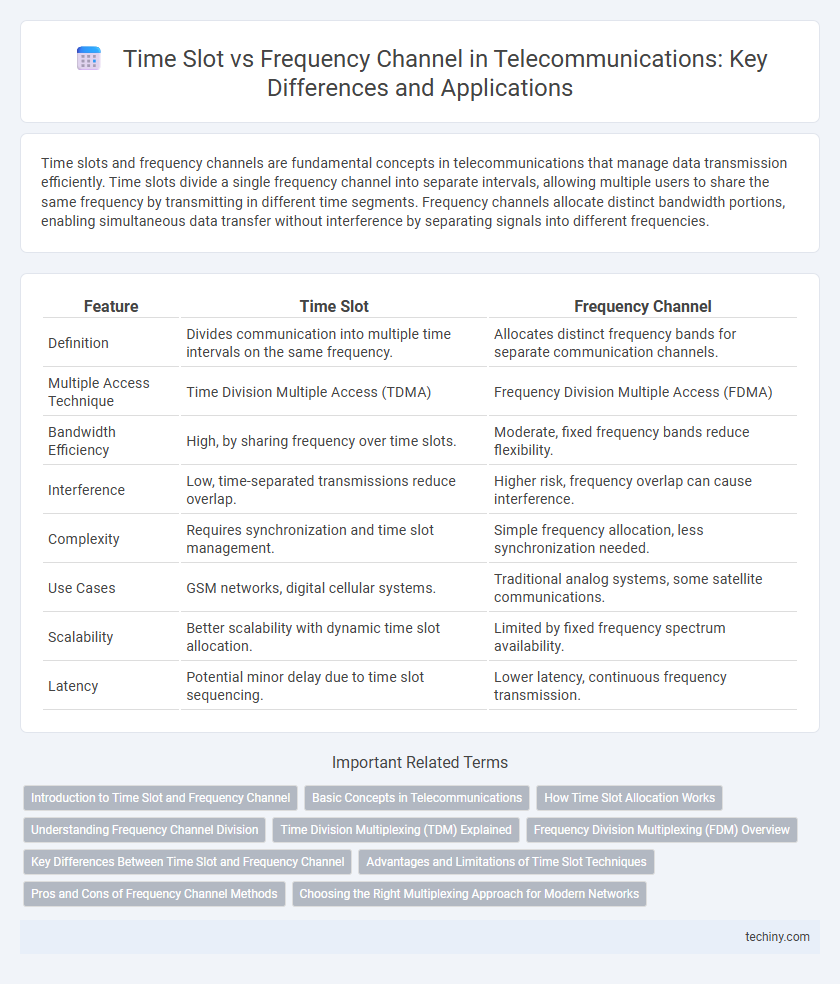Time slots and frequency channels are fundamental concepts in telecommunications that manage data transmission efficiently. Time slots divide a single frequency channel into separate intervals, allowing multiple users to share the same frequency by transmitting in different time segments. Frequency channels allocate distinct bandwidth portions, enabling simultaneous data transfer without interference by separating signals into different frequencies.
Table of Comparison
| Feature | Time Slot | Frequency Channel |
|---|---|---|
| Definition | Divides communication into multiple time intervals on the same frequency. | Allocates distinct frequency bands for separate communication channels. |
| Multiple Access Technique | Time Division Multiple Access (TDMA) | Frequency Division Multiple Access (FDMA) |
| Bandwidth Efficiency | High, by sharing frequency over time slots. | Moderate, fixed frequency bands reduce flexibility. |
| Interference | Low, time-separated transmissions reduce overlap. | Higher risk, frequency overlap can cause interference. |
| Complexity | Requires synchronization and time slot management. | Simple frequency allocation, less synchronization needed. |
| Use Cases | GSM networks, digital cellular systems. | Traditional analog systems, some satellite communications. |
| Scalability | Better scalability with dynamic time slot allocation. | Limited by fixed frequency spectrum availability. |
| Latency | Potential minor delay due to time slot sequencing. | Lower latency, continuous frequency transmission. |
Introduction to Time Slot and Frequency Channel
Time slots and frequency channels are fundamental concepts in telecommunications enabling efficient multiplexing and resource allocation. A frequency channel divides the available bandwidth into separate frequency bands for multiple users, while a time slot allocates specific time intervals within a frequency channel for data transmission. Combining time division multiplexing (TDM) and frequency division multiplexing (FDM) enhances network capacity and minimizes interference in communication systems.
Basic Concepts in Telecommunications
Time slot refers to a specific interval within a time-division multiplexing (TDM) system that allows multiple signals to share the same frequency channel by dividing transmission time into discrete segments. Frequency channel represents a designated portion of the electromagnetic spectrum allocated for the transmission of signals in frequency-division multiplexing (FDM) systems, enabling simultaneous communication over different frequencies. Understanding the distinction between these basic concepts is essential for optimizing bandwidth utilization and enhancing communication efficiency in modern telecommunications networks.
How Time Slot Allocation Works
Time slot allocation in telecommunications divides a frequency channel into multiple time slots, allowing multiple users to share the same frequency without interference. Each user is assigned a specific time slot, enabling efficient use of bandwidth and reducing collisions in time-division multiple access (TDMA) systems. This method improves channel capacity by synchronizing transmissions and minimizing overlapping signals within the allocated frequency spectrum.
Understanding Frequency Channel Division
Frequency channel division segments the available spectrum into distinct frequency bands, enabling simultaneous transmissions without interference by assigning each user or service a unique frequency channel. Unlike time slot division, which allocates different time intervals on the same frequency, frequency channel division reduces cross-channel interference and improves signal clarity in telecommunications systems. This method is fundamental for technologies like FDMA (Frequency Division Multiple Access), ensuring efficient bandwidth utilization and consistent communication quality.
Time Division Multiplexing (TDM) Explained
Time Division Multiplexing (TDM) allocates multiple data streams by dividing a single communication channel into distinct time slots, allowing each user exclusive access during their allocated interval. Unlike frequency channel multiplexing, which separates signals by different frequency bands, TDM maintains all signals on the same frequency but separates them sequentially in time. This technique maximizes the efficiency of digital transmission systems by enabling simultaneous data transfer over a single frequency channel without overlap or interference.
Frequency Division Multiplexing (FDM) Overview
Frequency Division Multiplexing (FDM) allocates distinct frequency channels to separate signals, enabling simultaneous transmission over a single communication medium without interference. Unlike Time Division Multiplexing (TDM), which assigns different time slots to signals, FDM divides the bandwidth into frequency bands, each carrying an independent data stream. This method is widely used in telecommunications to increase channel capacity and efficiently manage spectrum resources.
Key Differences Between Time Slot and Frequency Channel
Time slots are discrete intervals within a single frequency band that allow multiple users to share the same frequency channel by dividing access in the time domain, enhancing bandwidth efficiency in Time Division Multiple Access (TDMA) systems. Frequency channels, by contrast, represent separate carrier frequencies allocated to different users or signals, enabling simultaneous communication in Frequency Division Multiple Access (FDMA) systems. The key difference lies in the resource allocation method: time slots segment the channel over time, while frequency channels segment the spectrum over frequency.
Advantages and Limitations of Time Slot Techniques
Time slot techniques in telecommunications enable efficient multiplexing by dividing a single frequency channel into multiple time intervals, allowing simultaneous data transmission from multiple users. This method optimizes bandwidth usage and reduces interference compared to frequency channel allocation but faces limitations such as synchronization complexity and increased latency. Moreover, time slot techniques demand precise timing coordination to avoid overlapping signals and ensure data integrity in time-division multiplexing systems.
Pros and Cons of Frequency Channel Methods
Frequency channel methods allow simultaneous transmission of multiple signals by dividing the available bandwidth into distinct frequency bands, enhancing spectral efficiency and reducing interference. However, frequency channel allocation can lead to limited flexibility, increased complexity in hardware design, and potential channel fading issues due to multipath propagation. These methods are ideal for fixed, high-capacity systems but may struggle with dynamic or mobile environments where rapid resource reallocation is necessary.
Choosing the Right Multiplexing Approach for Modern Networks
Time slot multiplexing divides a single frequency channel into multiple temporal segments, enabling multiple data streams to share the same frequency band efficiently. Frequency channel multiplexing, or Frequency Division Multiple Access (FDMA), assigns distinct frequency bands to separate data streams, reducing interference but requiring broader spectrum allocation. Modern networks often combine both Time Division Multiplexing (TDM) and Frequency Division Multiplexing (FDM) to optimize bandwidth utilization, increase network capacity, and improve overall communication latency and reliability.
time slot vs frequency channel Infographic

 techiny.com
techiny.com